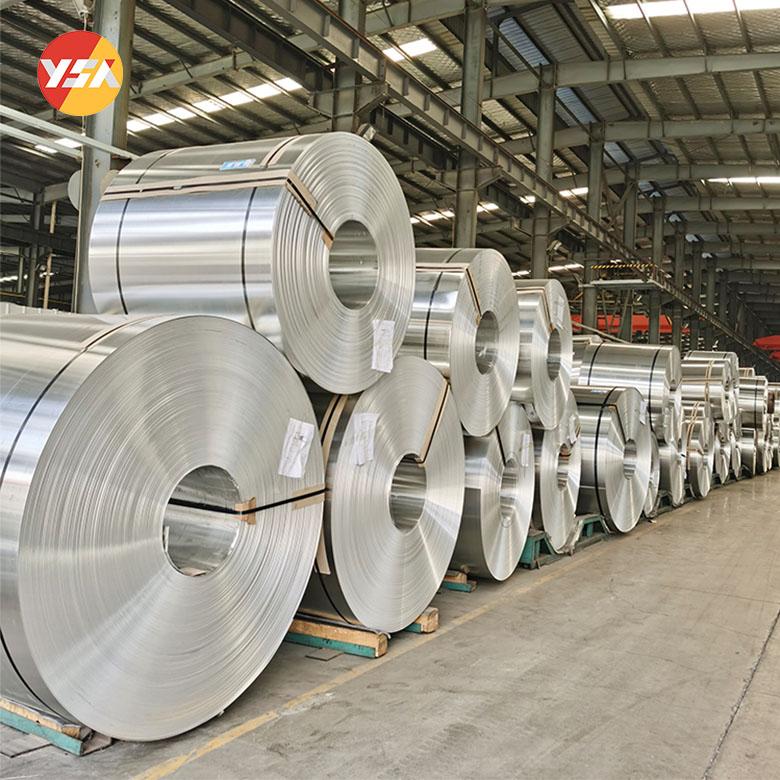Aluminum beverage cans are ubiquitous, with over 400 billion units produced globally each year. At the heart of this packaging revolution lies aluminum coil—a specialized rolled product engineered to meet stringent demands of weight reduction, product safety, and sustainability. This article explores the multifaceted reasons why aluminum coil dominates beverage can production, leveraging its unique properties to outperform alternatives like steel, glass, and plastic.
1. Lightweight Advantage: Efficiency from Production to Logistics
-
Density and Weight Savings
Aluminum’s density is one-third that of steel, enabling cans weighing ~13 grams—equivalent to three U.S. quarters. This lightweight property directly reduces material consumption by 40% compared to steel alternatives27. -
Logistics Optimization
Trucks transport 20% more aluminum cans than steel equivalents, slashing fuel consumption and CO₂ emissions. For example, shipping 1 million cans in aluminum saves ~1,000 kg of CO₂ versus steel210. -
Manufacturing Efficiency
High ductility allows coils to be thinned to 0.20–0.28 mm for can bodies and 0.208–0.292 mm for ends/lids, enabling high-speed stamping at rates exceeding 2,000 cans per minute212.
2. Superior Barrier Properties: Ensuring Product Integrity and Safety
-
Corrosion Resistance
Aluminum naturally forms a protective oxide layer, preventing interaction between beverages and metal. This eliminates flavor scalping and extends shelf life without chemical leaching213. -
Epoxy Coatings for Enhanced Safety
Inner coatings provide an additional barrier, especially for acidic beverages. These coatings comply with FDA/EFSA migration limits, ensuring aluminum ion transfer remains below 1% of the tolerable daily intake1213. -
Hermetic Sealability
Aluminum ends achieve leak-proof seals at thicknesses of 1.25–1.45 mm, critical for carbonated drinks requiring internal pressures up to 90 psi2.
3. Circular Economy Champion: The Recycling Advantage
-
Energy and Emission Savings
Recycling aluminum uses 95% less energy than primary production, reducing GHG emissions by 95%. A single recycled can saves enough energy to power a TV for 2 hours1014. -
Infinite Recyclability
Aluminum retains 100% of its properties after recycling, enabling "can-to-can" loops in 60 days. Countries like Germany and Brazil achieve recycling rates exceeding 90% due to efficient deposit-return systems1014. -
Economic Value in Recovery
Aluminum’s scrap value funds recycling infrastructure. Increasing the U.S. recycling rate from 45% to 90% could generate 104,000 jobs and $1.6 billion in economic activity14.
Table 1: Environmental Impact Comparison of Packaging Materials3614
| Material | Recycling Rate (%) | CO₂ Emissions (kg CO₂/kg) | End-of-Life Value ($/ton) |
|---|---|---|---|
| Aluminum | 65–75 | 11–16 (primary), 0.5–1.5 (recycled) | $1,400 |
| PET Plastic | 25–32 | 2–4 | $180 |
| Glass | 40–65 | 1.5–2.5 | $110 |
4. Technical Specifications: Alloys and Manufacturing Precision
Beverage cans use specialized alloys optimized for each component:
-
Can Bodies:
Balances formability and strength, with tensile strength (265–290 MPa) and earing values <3% to prevent uneven rim formation during deep drawing12. -
Ends/Tabs:
Higher magnesium content provides tensile strength up to 420 MPa, ensuring easy-open functionality without fracture712.
Table 2: Key Aluminum Alloys for Beverage Can Components712
| Component | Alloy | Thickness (mm) | Tensile Strength (MPa) | Key Properties |
|---|---|---|---|---|
| Can Body | 3104 | 0.20–0.28 | 265–290 | High formability, deep-drawing capability |
| Can End | 5052 | 0.208–0.249 | 330–365 | Rigidity, press formability |
| Tab | 5182 | 0.279–0.292 | 380–420 | Fracture resistance, bend durability |
5. Sustainability and Economic Synergy
-
Lifecycle Emissions Reduction
While primary aluminum production consumes 62–70 MJ/kg, recycled aluminum uses only 3–5 MJ/kg. Brands like Novelis recycle 82 billion cans/year, avoiding 12 million tons of CO₂ annually—equivalent to removing 2.6 million cars from roads1114. -
Closed-Loop Systems
Manufacturers integrate "can-to-coil" recycling: Post-consumer cans are remelted, rolled into coils, and reformed into cans within 8 weeks. This circularity reduces dependence on bauxite mining, which accounts for >70% of aluminum’s lifecycle impact1011. -
Policy Drivers
EU Single-Use Plastics Directives and U.S. "Buy Recycled" policies incentivize aluminum packaging. Lightweighting innovations further cut material use by 10% without compromising strength214.
6. Future Innovations: Enhancing Performance and Sustainability
-
Advanced Coatings
Development of bio-based epoxy and nanoceramic barriers aims to replace petrochemical-derived coatings, improving recyclability and reducing microplastic risks813. -
Digital Tracking
QR codes on cans enable traceability from collection to remelting, increasing consumer engagement and recycling accuracy14. -
Alloy Optimization
New magnesium-scandium alloys promise 20% higher strength for ultra-thin cans, potentially reducing aluminum demand by 100,000 tons/year in Europe alone711.
Conclusion
Aluminum coil remains the backbone of beverage can manufacturing due to its unmatched synergy of lightweight efficiency, product protection, and circular recyclability. As sustainability mandates tighten and consumer demand for eco-friendly packaging grows, aluminum’s advantages will only intensify. Innovations in alloy design, recycling infrastructure, and policy support will further cement its status as the optimal choice—transforming every discarded can into a resource for future packaging, not waste. With a recycling rate potential nearing 100%, aluminum coils don’t just make cans; they enable a truly circular economy.

